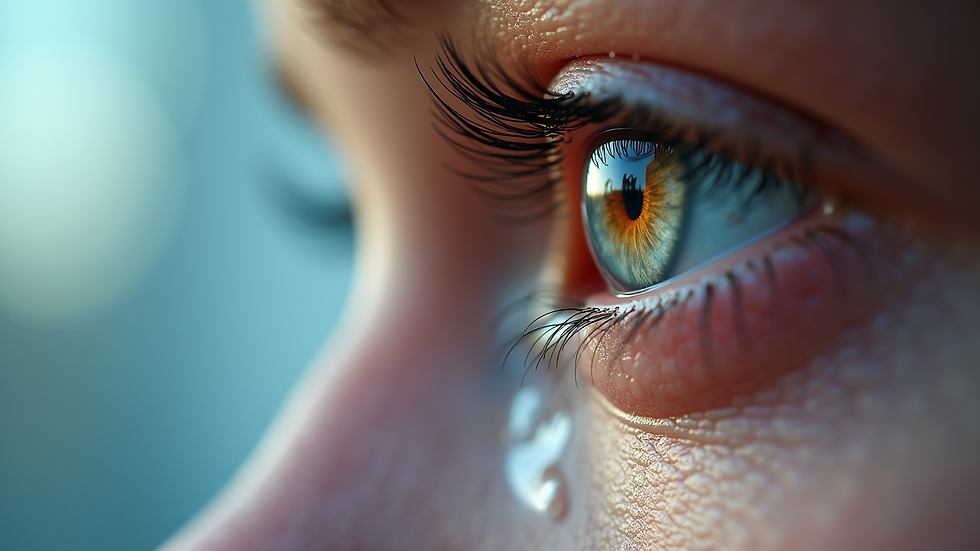What Causes Epiphora and How Can It Be Treated?
- sohraab yadav
- Jul 25
- 4 min read
Epiphora, commonly known as excessive tearing, can be a bothersome condition affecting individuals of all ages. It occurs when tears overflow onto the eyelid and down the face, rather than draining normally through the tear ducts. This blog post aims to explore what causes epiphora, its most common triggers, and the effective treatments available.
Excessive Tearing Causes
Epiphora can stem from various sources. The condition can be a symptom of an underlying issue rather than a standalone problem. Factors contributing to excessive tearing include:
Blocked Tear Ducts: This is the leading cause and occurs when the tear ducts become narrowed or blocked, preventing tears from draining properly.
Allergies: Allergic reactions to pollen, dust, or pet dander can lead to watery eyes. The body’s response to allergens often includes increased tear production.
Dry Eyes: Ironically, when eyes are dry, they may produce more tears to compensate. This can result in an overproduction of tears, contributing to epiphora.
Infections: Conjunctivitis or other infections can also lead to excessive tearing, as the eyes try to flush out irritants.
Eye Conditions: Conditions like eyelid malpositions or conjunctival abnormalities can prevent proper drainage.
Understanding the causes of epiphora is crucial to identifying suitable treatment options.

What are the Symptoms of Epiphora?
Identifying symptoms is key to determining whether epiphora is an issue. Symptoms generally include:
Continual tearing
Tears running down the face
Blurred vision in some cases
Eye irritation
Swelling around the eyes
If you experience any of these symptoms regularly, consider consulting a healthcare professional for a thorough examination.
What is the Most Common Cause of Epiphora?
The most frequent cause of epiphora is a blockage in the tear ducts. This blockage can result from various factors, including age or previous surgeries, and is common in infants, where duct development may not be complete.
How Blocked Tear Ducts Lead to Epiphora
Tear ducts can become blocked due to:
Infections: Conjunctivitis or sinus infections can cause inflamed tissue around the eyes, leading to blockages.
Tumors or growths: In rare cases, tumors pressing on tear ducts can obstruct tear flow.
Structural issues: Congenital abnormalities or aging may push the ducts out of alignment.
Awareness of the common causes assists in prompt diagnosis and treatment.

Diagnosing Epiphora
Diagnosis typically involves a comprehensive eye examination. During this evaluation, your healthcare provider may:
Conduct a History Review: Discuss any underlying conditions or medications that could contribute to excessive tearing.
Perform a Tear Film Breakup Time Test: This test assesses how long the tear film remains stable before breaking, indicating dry eyes.
Use Fluorescein Staining: A dye is applied to the eye, allowing observation of tear drainage and any blockages.
After a thorough examination, your healthcare provider can identify the appropriate treatment.
Treatment Options for Epiphora
Treating epiphora will depend on the underlying cause. Here are common treatment options:
Artificial Tears: If dry eyes are the issue, lubricating eye drops can provide relief.
Anti-Allergy Medications: For those experiencing allergic reactions, antihistamines or eye drops can control symptoms.
Warm Compresses: Applying warm, moist compresses can help relieve any blockage in the tear ducts.
Surgical Procedures: In cases of significant blockage, surgery may be required to reopen the ducts or create a new tear drainage pathway.
Results can vary based on the severity and cause of the epiphora.

Lifestyle Changes and Home Remedies
While professional treatments can be effective, some lifestyle changes can help manage epiphora. Consider these tips:
Stay Hydrated: Drink ample water to maintain eye moisture.
Avoid Allergens: Use air purifiers and keep windows closed during high pollen seasons.
Practice Good Eye Hygiene: Regularly clean the eye area to remove irritants.
Adjust Your Environment: Reduce exposure to smoke, dust, and other irritants that can trigger tearing.
Making these simple adjustments can go a long way in controlling symptoms.
Seeking Professional Help
If you continue to experience excessive tearing despite implementing lifestyle changes, seeking professional help is recommended. An eye care specialist can provide insights tailored to your situation.
It is essential not to ignore persistent symptoms, as they can indicate serious underlying issues that, if left untreated, may lead to more significant problems.
Understanding Prevention
Preventing epiphora may not always be possible, especially if due to genetic factors. However, awareness of risk factors can help you take suitable precautions.
For example, if you have a history of allergies, consult with a healthcare provider about preventive measures to manage them effectively. Additionally, application of sunscreen around the eyes can help safeguard against irritants and sun-related problems.
Final Thoughts
Epiphora affects many people and is often manageable with proper understanding and treatment. If you suspect you have this condition, take action by consulting an eye healthcare professional. Early diagnosis can lead to effective treatment, enhancing your quality of life.
By being aware of the symptoms and potential causes, you can better navigate this common yet frustrating issue. Don’t hesitate to invest in your eye health and seek the necessary treatments.
Recognizing and addressing excess tearing early can make a significant difference in your daily comfort.



Comments